Hancock III (Troop Transport)
1902-1925
John Hancock-- born 12 January 1737 in Braintree, Mass. -- graduated from Harvard College in 1754, and became the wealthiest merchant in Boston, Mass. He was President of the Massachusetts Provincial Congress and served as President of the Continental Congress from 24 May 1775 to 29 October 1777. As holder of this office, Hancock was the first signer of the Declaration of Independence. Hancock served the Continental Congress until he became Governor of Massachusetts in 1780 and he presided over the State's Constitutional Convention held that year. He also presided over the Massachusetts Convention of 1788, which ratified the U.S. Constitution. With the exception of a term in the Congress under the Articles of Confederation, 1785-86, Hancock was Governor of Massachusetts until his death on 8 October 1793. His body was interred in the Old Granary Burying Ground, Boston.
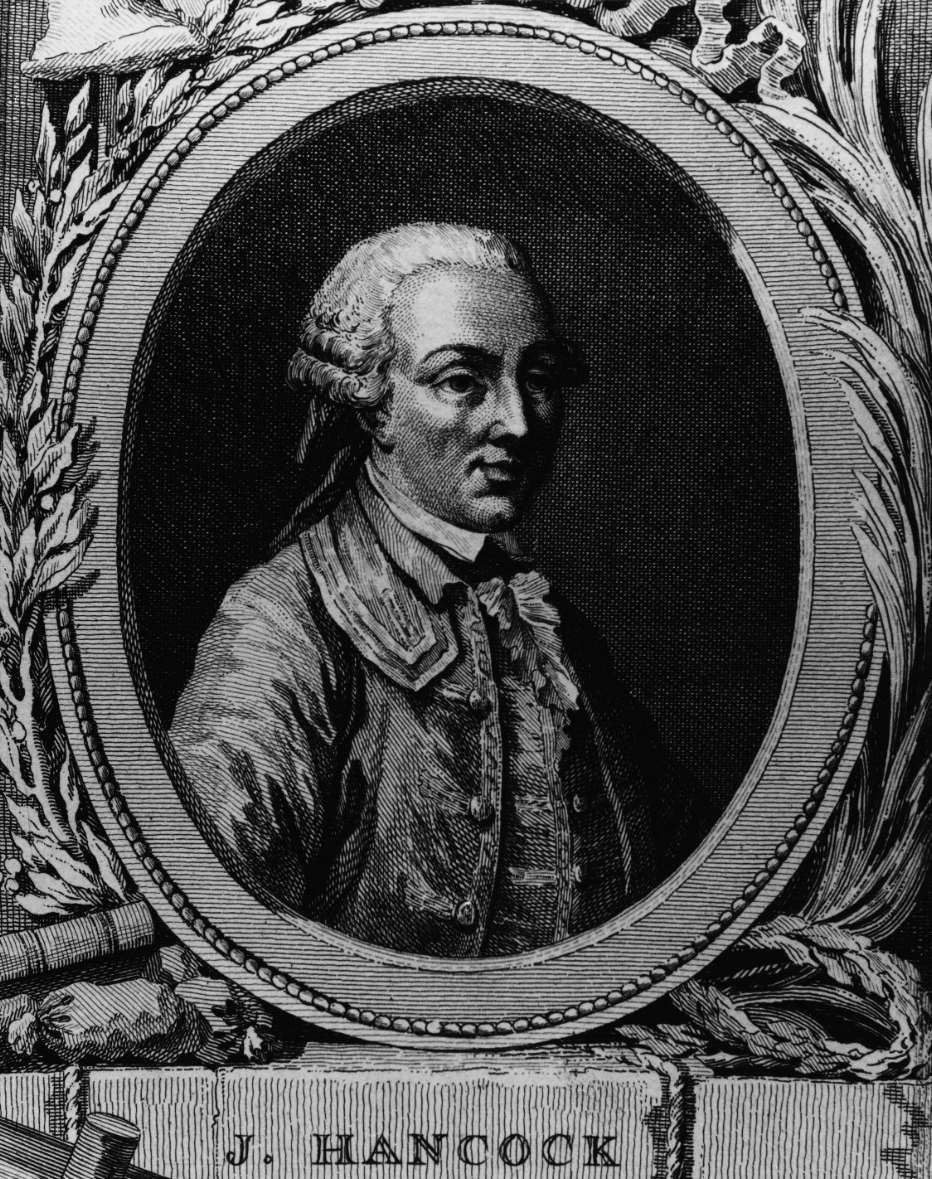
III
(Troop Transport: displacement 8,500; length 465'6"; beam 45'4"; draft 24'3"; speed 13 knots; complement 278; troop capacity 1,100; armament 6 3-inch, 2 3-pounders, 2 machine guns)
The third Hancock (Troop Transport) was built in 1879 by J. Elder & Co., Glasgow, Scotland. Formerly Arizona, she was purchased by the War Department during the Spanish-American War (1898) and transferred to the Navy Department on 8 November 1902. She was commissioned on 20 November 1902, Lt. Cmdr. Frederick W. Coffin in command.
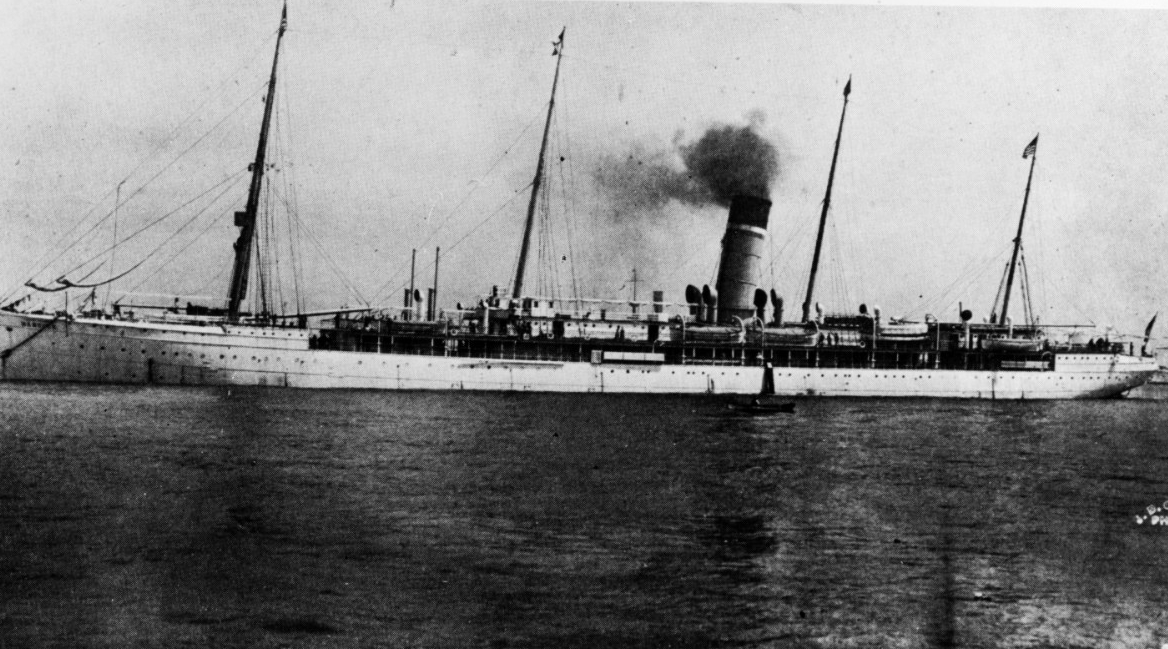
Hancock sailed from San Francisco for the East Coast on 14 December 1902, via Valparaiso, Chile; Montevideo, Uruguay; and Bahia, Brazil. She arrived at the New York Navy Yard, Brooklyn, N.Y., on 21 February 1903, and decommissioned on 9 March, for fitting out as a receiving ship. She recommissioned on 21 September, Capt. William H. Emory in command. She served at the New York Navy Yard, until relieved by Washington (Armored Cruiser No. 11), on 6 August 1913.

Hancock cleared New York on 15 September 1913, and arrived at the Philadelphia [Pa.] Navy Yard, the following day to be fitted out as a transport for U.S. Marines. She remained in the yard through the end of the year. Having embarked the 1st Provisional Regiment, Advanced Base Brigade, U.S. Marines, she cleared Philadelphia and steamed down the Delaware River into Delaware Bay on 4 January 1914, in company with the transport Prairie with the 2nd Provisional Regiment, Advance Base Brigade embarked. The transports were bound for the Caribbean, and arrived at Culebra Island, off Puerto Rico, on the 9th. Both ships landed their respective regiments for an exercise wherein the Advance Base Brigade assumed defensive positions in order to repel a notional invasion while the transports remained in the vicinity of the island. The force simulating the attacking force struck on 18 January. Capt. William S. Sims declared a victory for the defending force and with the exercise completed, the transports re-embarked the marines and departed Culebra, on 8 February. Steaming into the Gulf of Mexico, Hancock arrived at Pensacola, Fla., on 15 February. Two days later, with the marines still embarked, she shifted to New Orleans, La., where she remained well into April. Around this time tensions between the United States and Mexico escalated as a result of the Mexican Revolution as Gen. Victoriano Huerta aspired to the Mexican presidency.
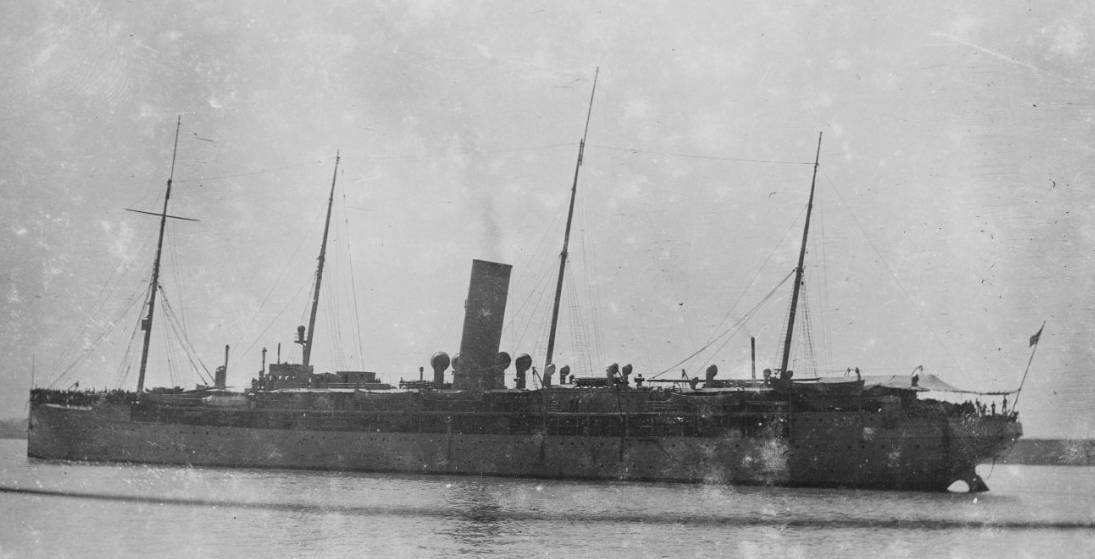
On 9 April 1914, the commanding officer of the gunboat Dolphin, at the Mexican port of Tampico, dispatched a purser and eight sailors to purchase fuel for the ship. Although the sailors were on board a whaleboat flying a U.S. flag, forces loyal to Huerta seized them and escorted them to the nearby regimental headquarters. Rear Adm. Henry T. Mayo, the commander of the Fourth Division, Atlantic Fleet, demanded a 21-gun salute and formal apology from Huerta's government. Huerta ordered the release of the sailors within 24 hours and gave a written apology, but refused to have his forces raise the U.S. flag to provide a 21-gun salute.
As a result of the “Tampico Affair,” President Woodrow Wilson asked Congress for permission for a landing at Vera Cruz, Mexico, and subsequently ordered the Atlantic Fleet to concentrate off that city. Departing New Orleans on 15 April, Hancock steamed to Tampico. Arriving on 17 April, she lingered offshore until 21 April. That day, at the direction of Rear Adm. Frank F. Fletcher, Capt. William R. Rush, commanding officer of Florida (Battleship No. 30), as the Naval Brigade commander, led a combined force of bluejackets and marines ashore. Lt. Richard Wainwright Jr. commanded the Florida Battalion which consisted of 13 officers and 272 enlisted men, organized into four companies. The fourth of these contained the artillery and machine guns. Marines from the Second Regiment on board Prairie also participated in the assault. These units, along with the Utah Battalion, seized the Customs House at Vera Cruz. Hancock shifted to Vera Cruz, arriving on 22 April. Landing her embarked marines under the command of Col. John A. Lejeune, USMC, who was then appointed to the command of all Marine forces in Vera Cruz by Rear Adm. Fletcher, Hancock remained until 29 April, when she departed with embarked refugees for Puerto Mexico, Mexico.
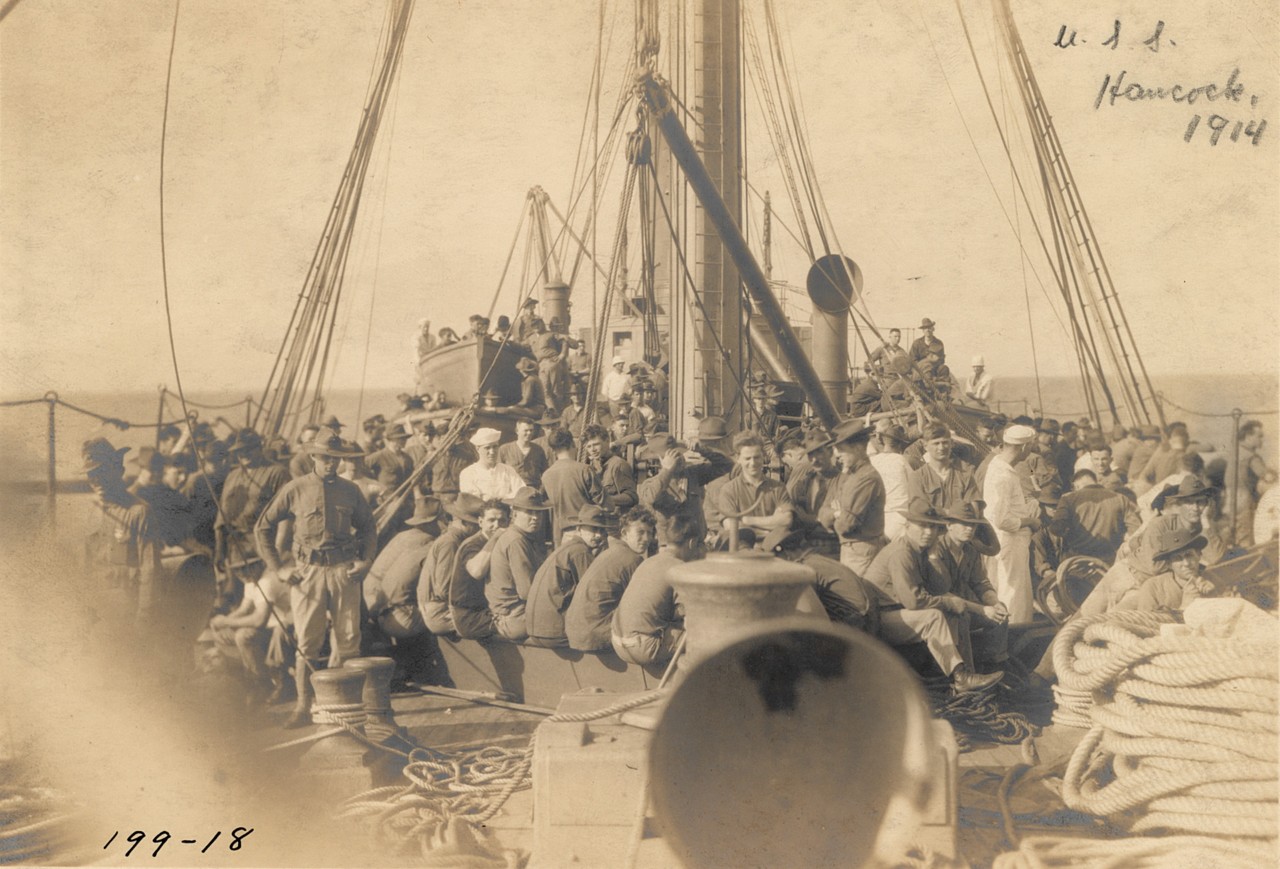
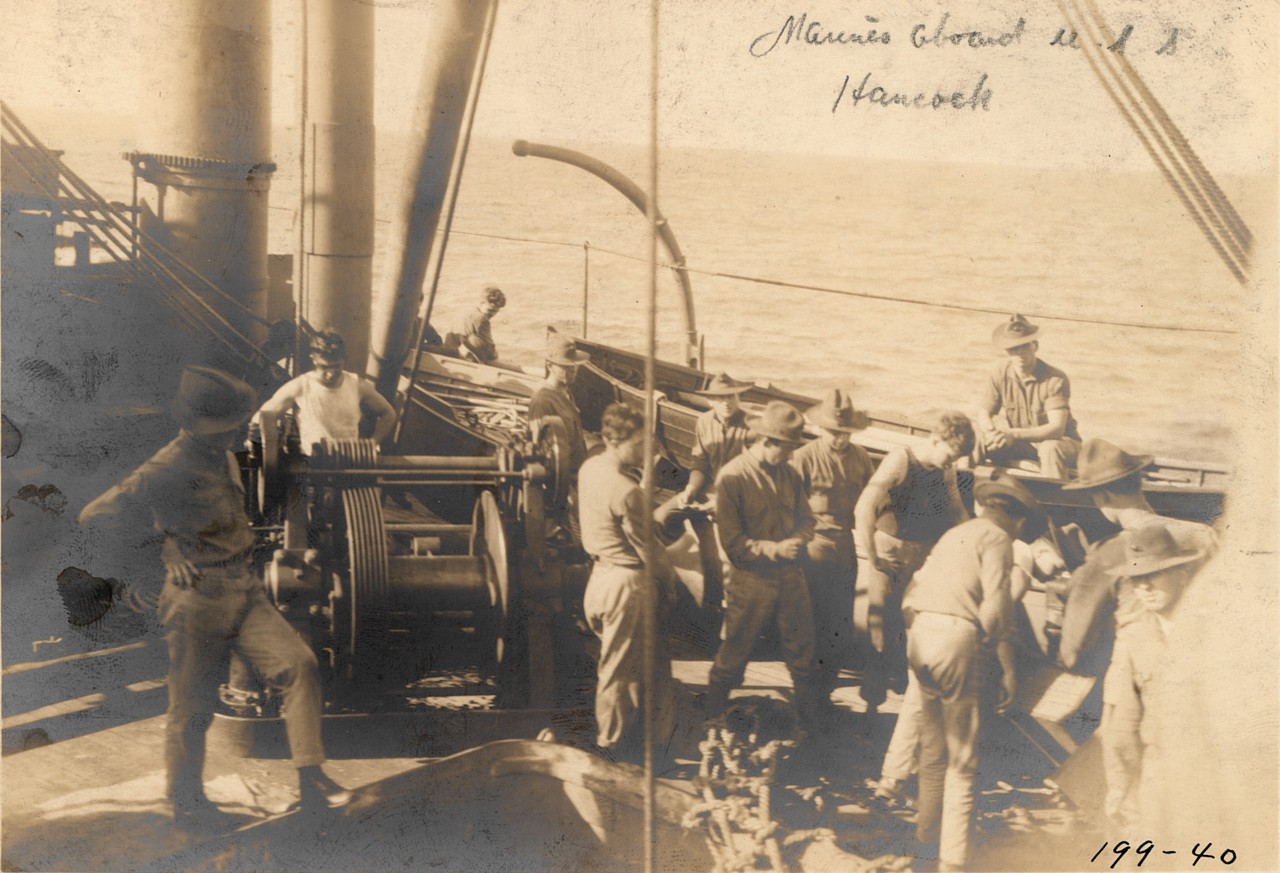
Arriving on 30 April 1914, she returned later that day to Vera Cruz, where she remained supporting the marines and bluejackets ashore until 23 May. Getting underway with a load of refugees, she steamed to Galveston, Texas. Arriving on 25 April, she debarked her passengers. She then took those who wished to return to Tampico on board and departed on 30 May. Arriving on 1 June, she debarked her passengers, and departed that same day for Vera Cruz, where she arrived the next morning. On 4 May, she was assigned to the Special Service Squadron supporting the U.S. Expeditionary Force in Mexico. She departed Vera Cruz on 23 May, bound for Galveston, arriving on 25 May. She departed Galveston on 30 May, and touched at Tampico, en route to Vera Cruz, on 1 June. She reached her destination the next day. She continued to operate off Vera Cruz, into July, when she departed on the 14th, with a battalion of embarked marines, and steamed to Guantanamo Bay, Cuba (19-20 July), after disembarking the battalion, she departed for Naval Operating Base (NOB) Norfolk, where she arrived on 25 July. After embarking the 5th Marine Regiment, Hancock got underway again on 30 July, she cleared the Chesapeake Bay, and proceeded southward for a return to Guantanamo Bay, and arriving on 4 August.
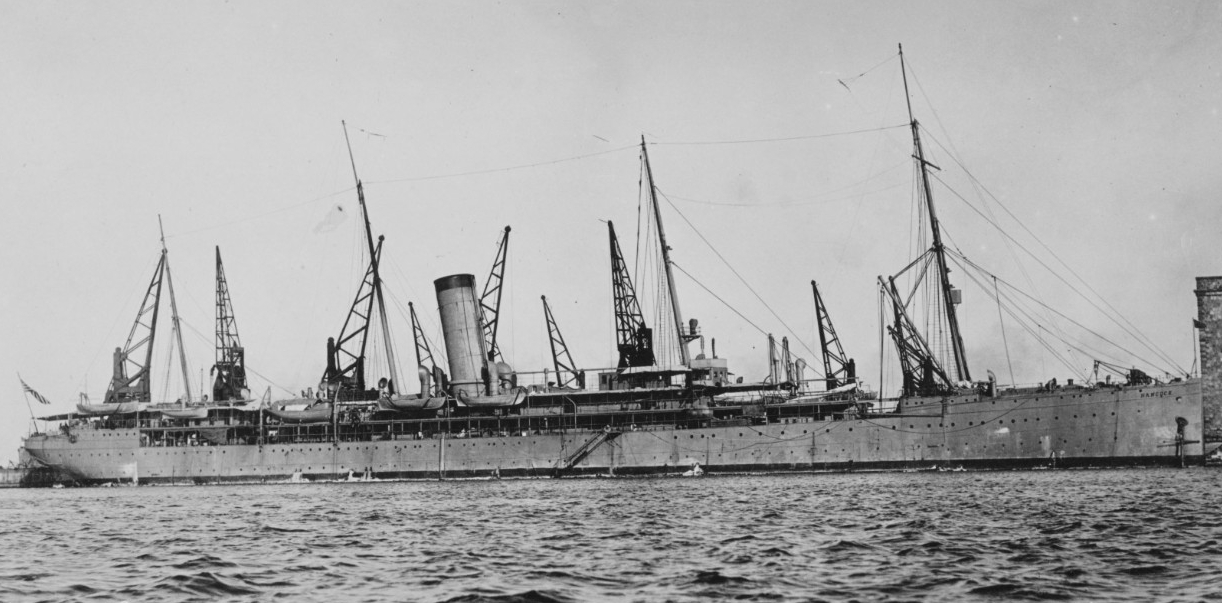
Other trouble spots also erupted in Latin America. Both countries on the island of Hispaniola, Haiti, and the Dominican Republic, were going through political unrest and violent revolutions endangering the lives and property of foreigners and inviting potential foreign intervention. This situation demanded a buildup of American strength in the area. Hancock departed Guantanamo Bay, on 14 August to cruise the waters off Hispaniola, to be on hand to protect American interests against any eventuality. She steamed to Puerta Plata, D.R. (15-23 August); San Pedro de Macoris, D.R. (24-28 August), Santo Domingo, D.R. (28 August-4 September); and Calderas Bay, D.R. (4-6 September), before returning to Santo Domingo, on 7 September. While at Santo Domingo, on 2 September, Hancock received orders detaching her from the Special Service Squadron and assigning her to the Cruiser Squadron, Atlantic Fleet. She remained at the Dominican capital until 13 October, when she steamed to Monte Cristi, D.R. Arriving on the 15th, she remained until 30 October, when she departed bound for Port-au-Prince, Haiti. Arriving at the Haitian capital on 31 October, she remained until 14 November, when she departed for Guantanamo Bay. Arriving the next day, she remained in port there until 24 November, then steamed to Santo Domingo, arriving on 26 November. While en route on 25 November, she was detached from the Cruiser Squadron, Atlantic Fleet. After over two weeks at Santo Domingo, the transport unmoored on 11 December, and steamed to Port-au-Prince, where she remained from 13-17 December, before getting underway for Philadelphia. She entered the Navy Yard on 23 December and docked.
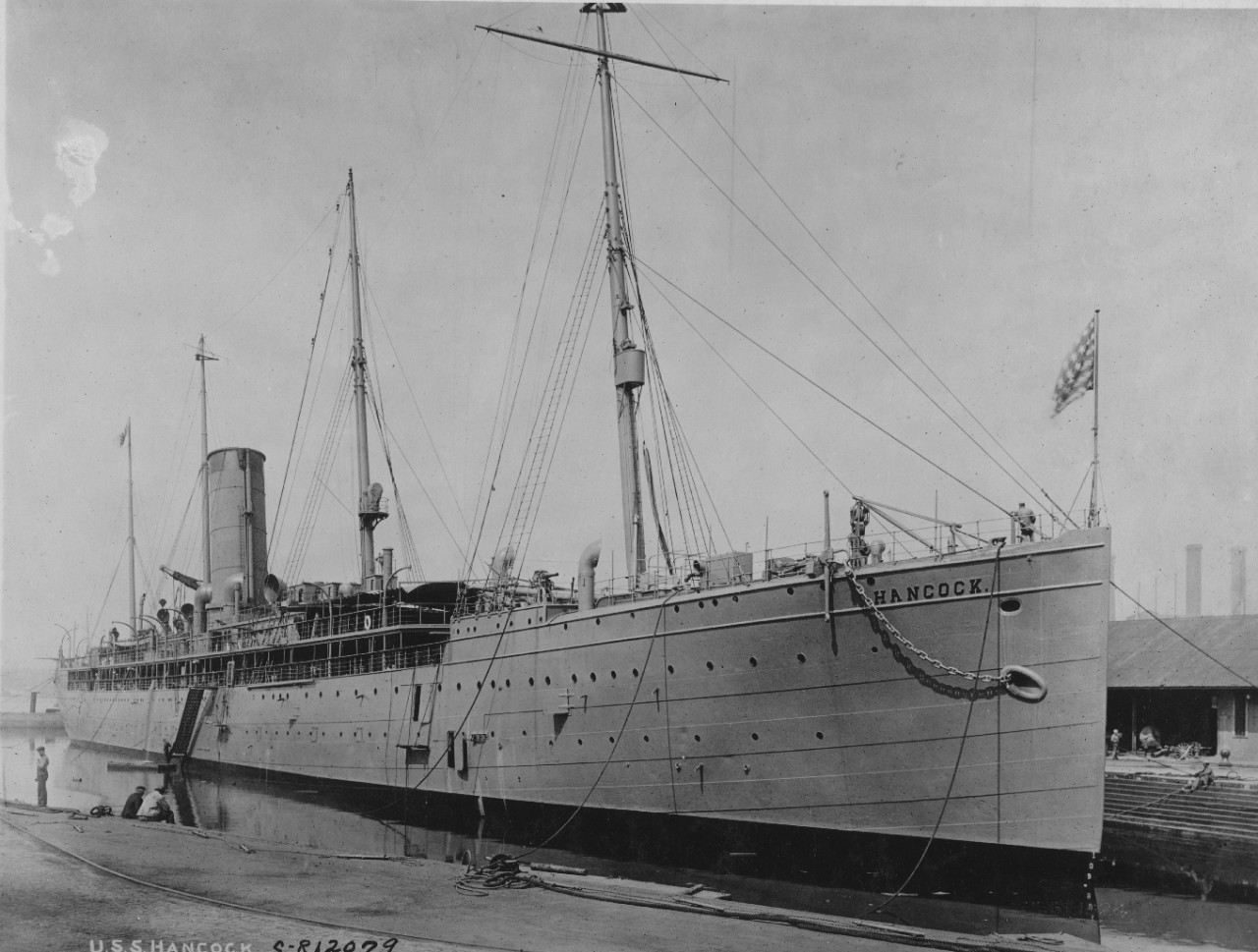
Hancock underwent overhaul at the Philadelphia Navy Yard, through the year 1915 and into 1916. The transport conducted post-overhaul trials (7-8 January 1916) which proved the ship’s engines wanting. She then underwent additional repairs which were completed on 29 January, as well as a second set of post-repair trials (1-4 February), which proved to be very good. She received orders on 15 March, directing her to proceed to Pensacola, and report to Commander, Submarine Flotilla, for exercises. She finally cleared Philadelphia, on 18 March for Pensacola. En route, she diverted and arrived at Galveston, on 26 March. She departed on 12 April, bound for a return to the waters off Vera Cruz, under the direction of the Commanding Officer, Senior Officer Present, Mexican Atlantic Waters, on board Nebraska (Battleship No. 14). Having resumed her duties cruising off Mexico, she received new orders on 4 June, directing her to proceed to New Orleans, to embark the 4th Regiment of Marines, under the command of Col. Joseph H. Pendleton, USMC, then en route by rail from Santiago, Calif., for urgent duty in the Dominican Republic (D.R.).
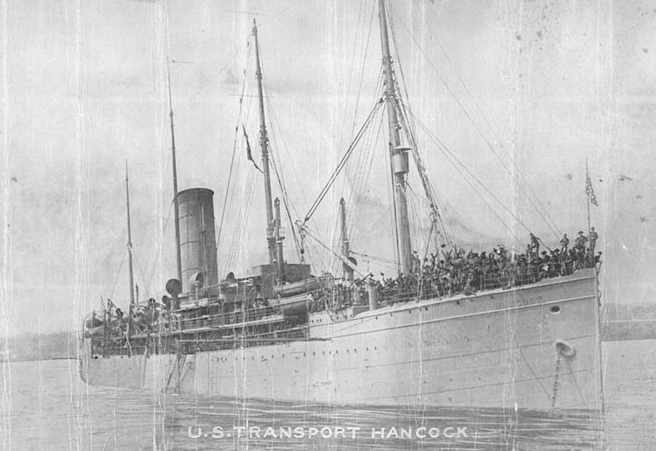
She moored in the Mississippi River, off New Orleans, on 8 June 1916. Having embarked Pendleton’s force, she steamed back down the river on 12 June, and out into the Gulf of Mexico. Standing in to Santo Domingo, on 18 June, she departed the next day and steamed to Monte Cristi (21-22 June), to disembark the 4th Marine Regiment, there. Proceeding to Guantanamo Bay (23-25 June), to refuel, she arrived back at Vera Cruz, on 30 June. She continued to cruise the waters of the Gulf of Mexico and Caribbean, transporting marines, stores, provisions, mail, and other cargo to forces ashore in Mexico and Hispaniola through the summer. Hancock assisted in the salvage of material from the forlorn Memphis (Armored Cruiser No. 10) (12-30 September after the ship was driven ashore by a tsunami in Santo Domingo harbor on 29 August. Departing on 2 October, Hancock touched at Port-au-Prince that same day, then proceeded northward carrying Memphis’ crew, stores, fittings, and ammunition to Hampton Roads, where they arrived on 7 October. The ship entered the Norfolk Navy Yard, Newport News, Va., two days later, and remained there until 27 October.
Clearing the Virginia capes on 27 October 1916, she touched at Charleston, S.C. (29 October), en route to Mayport, Fla. (30-31 October) and Guantanamo Bay (4-5 November), and arriving at Santo Domingo on 7 November. The next day, 8 November, the Commander, Cruiser Force, shifted his flag from the auxiliary cruiser Prairie to Hancock. With the commander embarked, she moved on to Puerta Plata (13-17 November); Sanchez, D.R. (18 November); Santo Domingo (20-22 November); Jacmel, Haiti (23 November); Aux Cayes (Les Cayes), Haiti (23 November), the on to Port-au-Prince on 24 November. Departing on the 25th, Hancock returned to Guantanamo, on 26 November, and remained there until getting underway again on 6 December. Returning to Hispaniola, the transport made multiple visits to ports in both Haiti and the Dominican Republic. Departing Port-au-Prince on 15 December, she returned to Guantanamo the next day. Leaving that same day, 16 December, she steamed back to Port-au-Prince. From the Haitian capital, she proceeded to visit Jacmel, Santo Domingo, and Calderas Bay, before departing from Puerta Plata on 22 December, bound for Philadelphia. Steaming up the Delaware River, she stood in to the Philadelphia Navy Yard, on 24 December, where she spent the Christmas and New Year’s holidays.
Hancock got underway again on 8 January 1917, and proceeded to Norfolk, entering the Navy Yard the next day. Departing on 12 January, she set a course for a return to Port-au-Prince via Charleston (14-16 January). Arriving on 18 January, she departed the next day and steamed to Guantanamo Bay, arriving on the 20th. Quickly turning around, she departed that same day and returned to Hispaniola, touching at Port-au-Prince, on the 21st. Departing the next day, she cruised off the island nations until 4 February, making visits to Santo Domingo (23-24 January); Sanchez (25 January); Puerta Plata (26 January); Monte Cristi (27 January); Port-de-Paix, Haiti (27-28 January); Cap-Haitien (28 January); and Puerta Plata (3-4 February), before returning to Guantanamo on 6 February. Departing two days later, she returned to Hispaniola, and through most of February cruised the waters of the troubled island. During this time, she visited Jacmel (10 February) and Santo Domingo (11-24 February), before returning to Guantanamo, to refuel on 26 February, Shifting to Guacanayabo Bay, Cuba, the next day, she rendezvoused with the Atlantic Fleet, which had consolidated there as a result of the increased tensions with Imperial Germany in the wake of the latter’s resumption of unrestricted submarine warfare. Departing on 2 March, she steamed to Port-au-Prince (3-4 March), before returning to Guantanamo Bay, on the 5th. Clearing Guantanamo, the next day, she proceeded back to Hispaniola, making visits to Cap-Haitien (7-9 March); Monte Cristi (9 March); Puerta Plata (10 March); Sanchez (11-14 March); Santo Domingo (15-20 March); Puerta Plata (20-22 March); Monte Cristi (22-23 March); Cap-Haitien (23 March); and Port-de-Paix (24-26 March). Taking leave of Hispaniola, she sped to Guantanamo.
Hancock lay at Guantanamo Bay, on 27 March 1917, when ordered to proceed to St. Thomas, in the Danish West Indies, where the Danish Government was to transfer the islands to the United States. She sailed the next day, embarking a Marine Detachment at Santo Domingo, on 29 March, she proceeded to St. Thomas, arriving the next day. On 31 March, Cmdr. Edwin T. Pollock, Hancock's commanding officer, took over the islands in the name of the United States. At 4:00 p.m., when the transfer became effective, Cmdr. Pollock assumed the position of Acting Governor of the U.S. Virgin Islands (U.S.V.I.), until relieved by Rear Adm. James H. Oliver on 9 April.
When the United States declared war on Imperial Germany on 6 April 1917, detachments from Hancock took possession of the German steamers Wasgenwald and Calabria, interned there. She remained at St. Thomas, until 22 April, when she got underway for Santo Domingo, arriving on the 24th; she quickly departed that same day, and made turns for Guantanamo Bay, reaching on 26 April. She left the next day bound for Haiti, and made visits to Port-au-Prince (28 April) and Cap-Haitien (29 April), before moving on to the Dominican Republic, where she visited Monte Cristi (29 April); Puerta Plata (30 April); Sanchez (1 May); and Santo Domingo (2-5 May), before returning to Cuba, standing in to Guantanamo Bay, on 7 May, to refuel. With another quick refuel, she departed that same day to return to Hispaniola, where she made visits to Port-au-Prince (8 May); Cap-Haitien (9 May); and Puerta Plata (10 May). Originally, receiving orders to New York, Hancock got underway on the 10th, but diverted to San Juan, Puerto Rico (P.R.). She arrived on 18 May, to take possession of two more interned German steamships, Präsident and Odenwald. The transport embarked 29 German prisoners of war on 23 May, and stood out of San Juan harbor, that afternoon to tow Odenwald to the Philadelphia Navy Yard, where she arrived 1 June. Having embarked 346 marines, Hancock got underway on 11 June. Bound for Tompkinsville, [Staten Island], N.Y. (Base No. 21), she was to rendezvous with other transports and escorts for the first American Expeditionary Force (AEF) troop convoy to France. Arriving on 13 June, she received orders that same day assigning her to the U.S. Cruiser and Transport Force under Rear Adm. Albert Gleaves.
Hancock got underway on 17 June 1917 as flagship of Troop Convoy Group Number 4, accompanied by St. Louis (Cruiser No. 20), the four cargo ships USAT Montanan, USAT Dakotan, USAT El Occidente, and USAT Edward Luckenbach and the escorts Shaw (Destroyer No. 68), Ammen (Destroyer No. 35), Flusser (Destroyer No. 20), and Parker (Destroyer No. 48). The oilers Kanawha (Fuel Ship No. 13) and Maumee (Fuel Ship No. 14), preceded the convoy to refuel the destroyers at sea as required. All arrived without mishap at St. Nazaire, France, on 2 July. Hancock, Finland (Id. No. 4543), San Jacinto (Id. No. 1531), and the steamer Antilles, escorted by St. Louis, Charleston (Cruiser No. 22), and the destroyers that arrived on 8 July, sortied as Group Three, from St. Nazaire, on 9 July. She returned to Philadelphia, on 22 July. With her first transport mission to France and back again, successfully completed, Hancock was in need of extensive repairs. Upon the completion of those, she would return to her transport and logistics duties supporting U.S. Marine commands serving as constabulary forces in the Caribbean.
With the completion of her overhaul, Hancock cleared the Philadelphia Navy Yard on 30 September 1917, and steamed southward for a return to the Greater Antilles via Charleston (3 October). The transport arrived at Port-au-Prince on 7 October, and she remained there until 10 October, when she shifted to Santo Domingo (12 October), before moving on to St. Thomas (13-15 October), en route to a return to Santo Doming on 16 October. Departing that same day, she moved on to Port-au-Prince (18 October), before clearing the Haitian capital to return to Hampton Roads, which she did on 23 October. While in the lower Chesapeake Bay, she entered the Norfolk Navy Yard, Newport News, Va. and underwent overhaul until 29 October. After her repairs, cleared the yard and proceeded into the Gulf of Mexico. At Galveston, Texas, on 27 November, she was authorized by Secretary of the Navy Josephus Daniels, to transport cotton from the Galveston Cotton Exchange to New York in order to give relief to the overburdened domestic rail lines and provide the factory workers in New England with needed raw materials for textile manufacture in support of the war effort. Having transported the cotton, she off-loaded her cargo, and departed New York on 22 December. Bound for Philadelphia, she reached her destination later that same day and upon arrival embarked members of the First Marine Aeronautic Company.
On 9 January 1918, Hancock, escorted by Terry (Destroyer No. 25) and Beale (Destroyer No. 40), departed Philadelphia for the Azores. The transport carried Rear Adm. Herbert O. Dunn, Commander, Azores Detachment, his staff, the First Marine Aeronautic Company, and a 50-man Marine Expeditionary Company, along with two 7-inch guns intended for the defense of Ponta Delgada, Azores (Base No. 13). Originally bound for Ponta Delgada, Azores, the three ships were diverted to Horta, Fayal, Azores, because Terry had insufficient fuel to raise Ponta Delgada. Having arrived at Horta, on 19 January, Beale steamed to Ponta Delgada to procure fuel for her fellow destroyer and Hancock. After her return and having refueled, the three ships departed Horta, on 21 January, and stood into Ponta Delgada, the next morning. On 28 January, Rear Adm. Dunn, raised his flag ashore as Commander, Azores Detachment. On 3 February, Hancock departed in company with Nokomis (S. P. 609) for the United States. While en route, Hancock received orders on 8 February, to search for the British tanker Eupion, which was believed to be in distress. The search continued into the 10th, but the vessel was never found. Resuming her transit back to the U.S., she arrived at Hampton Roads, on 16 February. Three days later, she cleared the Chesapeake Bay, and steamed to Philadelphia, where she entered the Navy Yard for repairs the next day.
With the completion of her yard work, Hancock departed Philadelphia on 15 March 1918, with embarked passengers and cargo for Ponta Delgada, and arrived on 24 March. She remained in the Portuguese archipelago, until 4 April when she got underway for a return to the U.S., making landfall at New York on 14 April, she discharged her cargo. Clearing New York on 17 April, she steamed past the Virginia capes and moored at Hampton Roads, the next day. Having embarked 1,061 troops of A Company and D Company, 310th Labor Battalion, and B Company and D Company, 309th Labor Battalion, Hancock departed Hampton Roads on 24 April 1918, bound for Brest, France, via Ponta Delgada. She arrived on 3 May. Getting underway again on 8 May, she was escorted by the American tug San Louis, six French tugs, and seven French subchasers. Later, that first day out, Hancock had a glancing collision with the chaser CL-142. As damage was slight, they continued their transit. On 13 May, the convoy commander determined that the slow speed of the tugs, endangered the transport in the “war zone.” Hancock parted with the tugs, and proceeded at speed with the subchasers. En route, they were joined by Smith (Destroyer No. 17) who escorted them in to Brest on 14 May. Upon arriving, the transport disembarked her troops. Clearing the French port on 25 May, she departed in company with the transports Lenape (Id. No. 2700) and Wilhelmina (Id. No. 2168), and the Italian transports Dante Alighieri, Caserta, and D’Aosta, escorted by Rowan (Destroyer No. 64), Tucker (Destroyer No. 57), Sampson (Destroyer No. 63), Jenkins (Destroyer No. 42), Benham (Destroyer No. 49), Cummings (Destroyer No. 44), and Jarvis (Destroyer No. 38). After three days, Hancock parted company with the convoy and steamed alone to Ponta Delgada, arriving on 31 May. She remained there until 3 June, when she got underway bound for Virginia. En route she posted special submarine lookouts as she was advised that U-151 (Korvettenkapitän Heinrich von Nostitz und Jänckendorff commanding) was operating in the western Atlantic. The transport raised the capes and then anchored in Lynnhaven Roads, Va., on 13 June. The next day, she shifted to Hampton Roads, to coal.
Hancock departed on 16 June 1918, in company with the submarine chasers SC-200 and SC-201, en route to Charleston. After rounding Cape Hatteras, N.C., the subchasers parted and returned to Hampton Roads. Continuing on, the transport reached Charleston, on 17 June, and entered drydock at the Charleston Navy Yard, the next day, and remained there undergoing repairs into July. She departed Charleston with marines attached to the 3rd, 4th, 7th, and 9th Regiments and the 2nd Provisional Brigade embarked, on 11 July. Bound for Guantanamo, she arrived on 15 July, disembarked her marines, and coaled. She departed on the 17th, and shifted to Santiago, Cuba, conducting target practice en route. After her arrival, she unloaded cargo and transferred 203 men of the 7th Regiment, U.S. Marines, ashore for duty. The next day, she embarked 205 marines for passage to the U.S., and departed for Port-au-Prince. Arriving on 19 July, she transferred marines for duty ashore and embarked marines for passage to the U.S. Clearing the Haitian capital, on 20 July; she proceeded to the Dominican capital at Santo Domingo, reaching on 22 July. Upon arrival, a lighter brought 308 marines alongside for passage to the U.S., and the transport debarked those marines of the 3rd and 4th Regiments assigned to duty ashore. She departed the next day, and moved on to Puerta Plata (24-25 July). While there, Hancock exchanged 408 marines for duty ashore with 304 marines bound for a return to the U.S. She then continued on to Cap-Haitien (25-26 July), where she exchanged 54 marines of the 2nd Provisional Brigade for duty ashore with 38 bound for a return home. Departing Cap-Haitien, she was initially bound for Charleston, but received orders by wireless to divert to Guantanamo Bay, where she arrived on 27 July, to coal and await further instructions. While there, she received stores and embarked 400 additional marines on 29 July. The next day, 43 officers and 683 men of the 2nd and 3rd Battalions, Headquarters Detachment, and the 14th Company, U.S. Marines, reported on board for passage to the U.S. Departing at 4:30 p.m., that same day, she steamed to Galveston, in company with Yorktown (Gunboat No. 1), and arrived on 5 August. The next day, she disembarked the 9th Regiment, U.S. Marines, and then departed Galveston, for Charleston, on 7 August. Still in company with Yorktown, the ships stood in to Charleston, on 12 August, and the 3rd Regiment, U.S. Marines, disembarked for duty ashore. Standing out of Charleston on 14 August, she set a course for Hampton Roads, and arrived the next day. Shifting to the Norfolk Navy Yard, on 19 August, she received stores and provisions while awaiting further orders. On 21 August, a U.S. Army detachment of 35 men reported on board for passage to San Juan.
Departing that day, in company with Montgomery (Destroyer No. 121), she arrived on 27 August 1918. Disembarking 33 troops, she embarked a 926-man, U.S. Army Detachment bound for the Canal Zone. Having taken the troops on board, she departed that same day and stood in to Colon, C.Z., on 31 August, disembarking all troops. Embarking over 700 troops, she departed the Canal Zone, on 3 September, bound for New Orleans. Reaching the Crescent City on 8 September, all those embarked were transferred ashore that same day. Clearing New Orleans on 11 September, she steamed back to San Juan, where she arrived on 18 September, to receive 1,229 Puerto Rican laborers for transport to the U.S. Leaving the same day as her arrival, she reached New Orleans, on 24 September, and disembarked the laborers. Departing for a second transfer of Puerto Rican laborers, Hancock arrived at San Juan on 4 October, took on 1,236, and clearing the next day. With a change of orders, she steamed to Savannah, Ga., where she arrived on 11 October, and disembarked the laborers. Departing on 14 October, she returned to San Juan, on 19 October, embarked another contingent of 1,253 laborers, and departing on 20 October, steamed to Charleston, where the laborers disembarked on 25 October.
Hancock got underway and steamed out of Charleston, on 30 October 1918, bound for the Philadelphia Navy Yard. Arriving the next day, 1 November, she took equipment for the First Regiment, U.S. Marines, on board. The following day the marines under Col. Thomas C. Treadwell, USMC, embarked, and the ship left the Navy Yard, en route to Guantanamo Bay. Reaching on 8 November, the regimental units disembarked. Departing on 10 November, for San Juan, she received a wireless message while en route, “Armistice signed 5:00 a.m.11th. Hostilities cease at 11:00 a.m. G.M.T. (Greenwich Mean Time).” She arrived at San Juan, on 12 November. The next day, she departed for Hampton Roads, and arrived on 18 November. She shifted to the Norfolk Navy Yard, on 22 November, and underwent repairs that lasted until 9 December. Clearing the yard the next day, she steamed southward, then into the Gulf of Mexico, reaching New Orleans, on 18 December. She got underway with 1,188 Puerto Rican laborers on board, on 20 December, bound for San Juan. Arriving on Boxing Day, she disembarked the labor contingent, then quickly got underway bound for Charleston, where she arrived on New Year’s Eve.
Spending the New Year’s holiday in port, Hancock got underway again on 4 January 1919. Standing out into the Atlantic, she carried 747 Bahamian laborers, bound for Nassau, New Providence Island, British Bahamas. Arriving on 6 January, she discharged her passengers, and cleared that same day for Norfolk, where she arrived on 9 January. With 988 marines embarked, she cleared Norfolk, on 17 January, bound for Guantanamo Bay, via Charleston. Taking on stores at Charleston (19-21 January), she proceeded to Guantanamo Bay and arrived on 23 January. Disembarking the marines and unloading their cargo, she departed on the 28th, for Port-au-Prince (29 January) and Santo Domingo (31 January-1 February), before moving on to St. Thomas. Arriving the next day, she disembarked 125 marines. She departed on 4 February, and that same day, lay off Christiansted, St. Croix, U.S.V.I, and disembarked another marine contingent. She then shifted to Puerta Plata (5 February), then on to Cap-Haitien (6-7 February) where she discharged cargo. Getting underway on the 7th, she arrived at Hampton roads on 12 February. She departed again on 18 February, with Rear Adm. Thomas Snowden and 1,245 marines and passengers on board. Arriving at Guantanamo Bay, on 23 February, she disembarked 105 marines and equipment, then proceeded that same day for Santo Domingo. Arriving on the 25th, she disembarked Rear Adm. Snowden and his family, along with 53 marines. She cleared the Dominican capital the next day, and stood in to San Pedro de Macoris, where she unloaded cargo and debarked 850 marines. Remaining a few days, she got underway on 1 March, and steamed to the Canal Zone, reaching Cristóbal, on 5 March. Two days later, she embarked U.S. Army troops, stores, baggage, and cargo, and left Cristóbal, the next day for Puerto Rico. Arriving at San Juan, on 12 March, she disembarked troops and discharged cargo. Departing San Juan on 15 March, she steamed for a return to Cristóbal. Reaching on 19 March, she again embarked troops and loaded their baggage and equipment, and then departed on 21 March, for San Juan, where she arrived and unloaded on 26 March. On 28 March, she embarked passengers for a return to the U.S., and departed for Galveston, arriving on 5 April; she loaded stores and equipment, and embarked troops. Departing on 10 April, she arrived at Guantanamo, on 17 April. Embarking marines, she departed the same day as her arrival, and arrived at Port-au-Prince, the next day, and disembarked those marines and their equipment going ashore. Leaving that same day, 18 April, she set a course for the Philadelphia Navy Yard, and steaming up the Delaware River, she arrived on 24 April, to undergo repairs and overhaul.
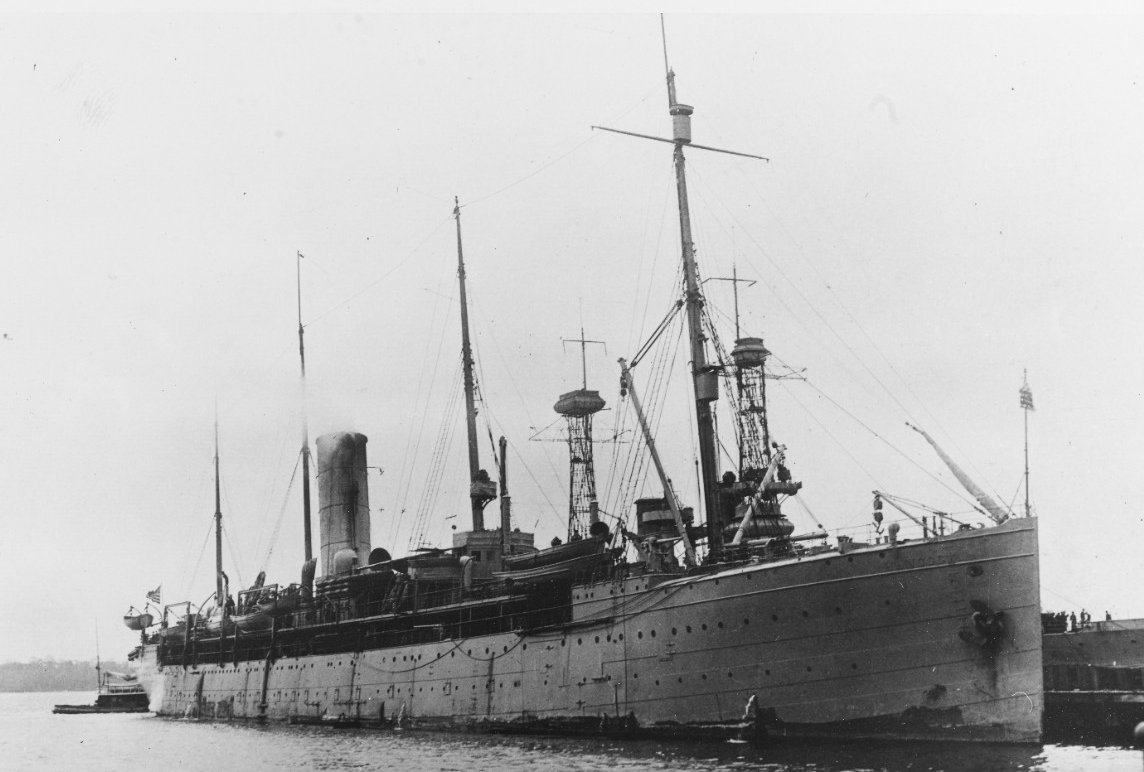
With her repairs completed, fully provisioned, fueled, and loaded with stores and equipment, Hancock departed Philadelphia on 14 June 1919, and arrived at Guantanamo Bay on the 19th. Having discharged stores and embarked marines and their equipment, for the U.S., she moved on to a return via Port-au-Prince (21 June), to the U.S. Arriving back at the Philadelphia Navy Yard on 26 June, she unloaded stores and equipment, and landed the marine contingents on board.
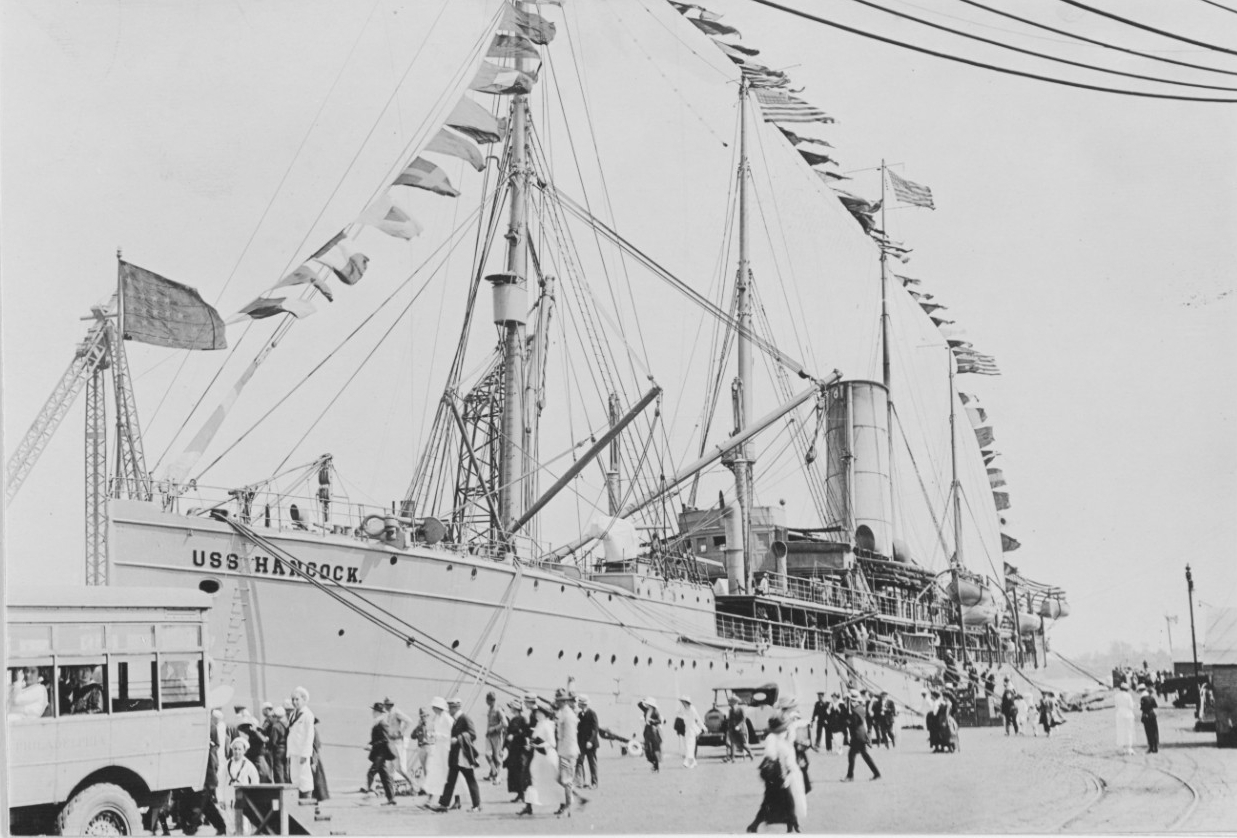
After a time in the yard, she departed on 3 August 1919, again headed southward. She arrived at Santo Domingo, on 21 August, then moved on to San Pedro de Macoris (21 August), Port-au-Prince (23-25 August), and Guantanamo Bay (26-29 August), before returning to the Philadelphia Navy Yard on 3 September. She underwent decommissioning preparations at the New York Navy Yard (9-20 August), but returned to the Philadelphia Navy Yard on 3 September. Hancock was detached from the Cruiser and Transport Force, and was assigned to Special Duty with the Marine Corps. Despite this assignment, on 26 September, the Office of the Chief of Naval Operations recommended that Hancock be decommissioned, which occurred on 18 October 1919.

Despite being placed on a list of ships to be sold on 4 December 1919, Hancock was recommissioned on 15 March 1920, Lt. Thomas J. Virden, USNRF, in command, and departed Philadelphia on 2 April for Rosyth, Scotland, to man and fit out the former German ships Ostfriesland and Frankfurt, which had been allocated to the United States. On 17 July 1920, Hancock was designated AP-3 as part of a Navy-wide administrative re-organization. She returned to New York with the ships on 9 August. Returning to the Philadelphia Navy Yard afterward, she resumed transport duties on 5 October 1920, departing Philadelphia for Hampton Roads (6-9 October) and Charleston (13-17 October), before steaming to Guantanamo Bay, and arriving on 17 October. Departing Cuba on 20 October, she steamed to Hispaniola, making stops at Port-au-Prince (21-22 October), Santo Domingo (24-25 October), San Juan (26 October), St. Thomas (26-28 October), Puerta Plata (30 October), and Cap-Haitien (1-2 November). Returning to the U.S, she stood in to Charleston, on 6 November. Reloaded with stores, she departed the Navy Yard on 15 November, and steamed to Guantanamo (19-22 November), before continuing on to her circuit of Hispaniola. The transport called at Port-au-Prince (23-26 November), Santo Domingo (28 November-1 December), San Juan (2 December), St. Thomas (2-4 December), Sanchez (5-6 December), Puerta Plata (7-8 December), and Cap-Haitien (9-10 December) before steaming back to Virginia, and mooring at Hampton Roads on 15 December. Having spent Christmas in port, she got underway again on 28 December, and transited via Charleston (30-31 December), made her way to Guantanamo, reaching on 4 January. Departing the next day, she steamed to Port-au-Prince (6-10 January), en route to Santo Domingo (12-15 January), San Juan (16 January), St. Thomas (16-17 January), Puerta Plata (19-20 January), Cap-Haitien (20-22 January), before steaming back to the U.S., and standing in to Hampton Roads ,and anchoring in the harbor, on the 27th.
Hancock departed Hampton Roads that same day, 27 January 1921, and steamed to the Philadelphia Navy Yard. Arriving the next day, she underwent repairs until 5 March, when she undocked and headed south to return to Hampton Roads, arriving on 6 March. Departing on the 15th, she set a course for the Canal Zone (C.Z.), and future service in the Pacific. A return trip from this duty was not contemplated. Arriving at Cristóbal, on 22 March, she refueled the next day, and then transited the Panama Canal, on 26 March. The transport entered the Pacific Ocean, and arrived at Balboa, C.Z., that same day. Departing on 30 March, she touched briefly at San Pedro, Calif., before getting underway again and steaming to San Francisco Bay. She arrived at Mare Island (Calif.) Navy Yard, via San Francisco, on 20 April, and underwent maintenance there until 3 May. Undocking, she shifted to San Francisco until 5 May, when she got underway, and clearing the Golden Gate, steamed westward for the Hawaiian Territory. The ship arrived at Pearl Harbor, Hawaiian Territory, on 14 May, then briefly shifted to Honolulu on the 18th, before returning that same day to Pearl Harbor. Hancock served as a receiving ship there into 1925.
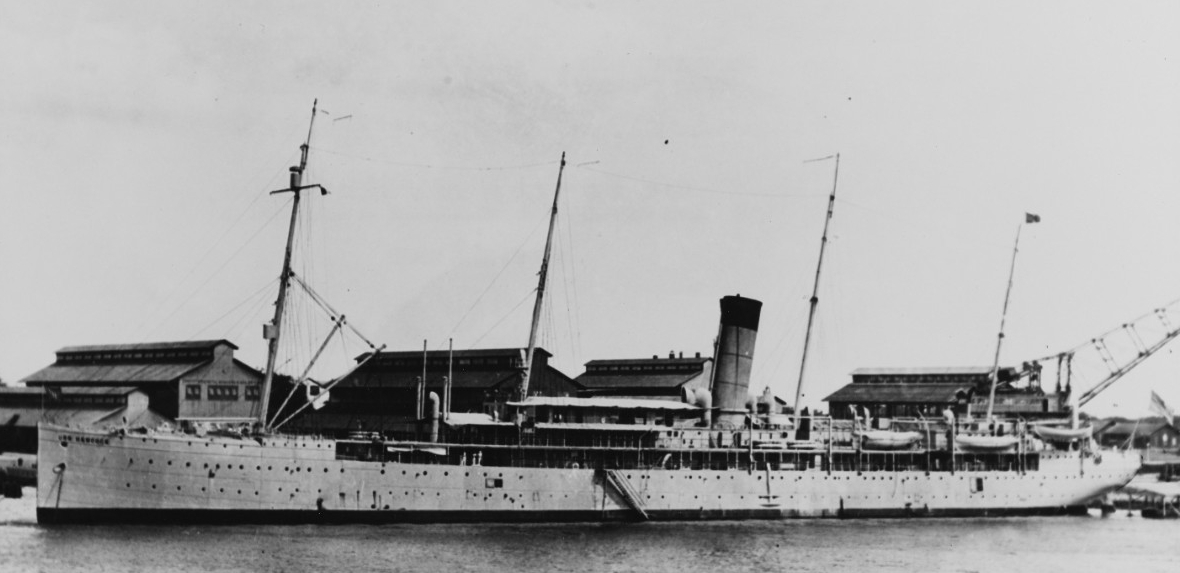
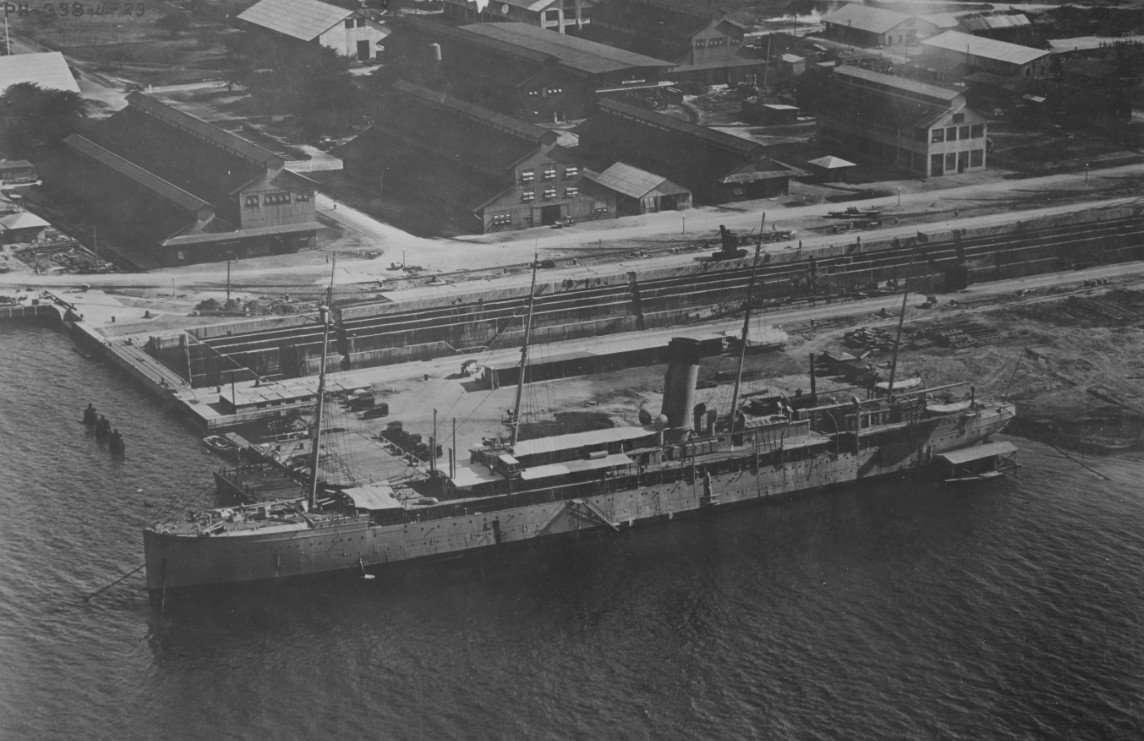
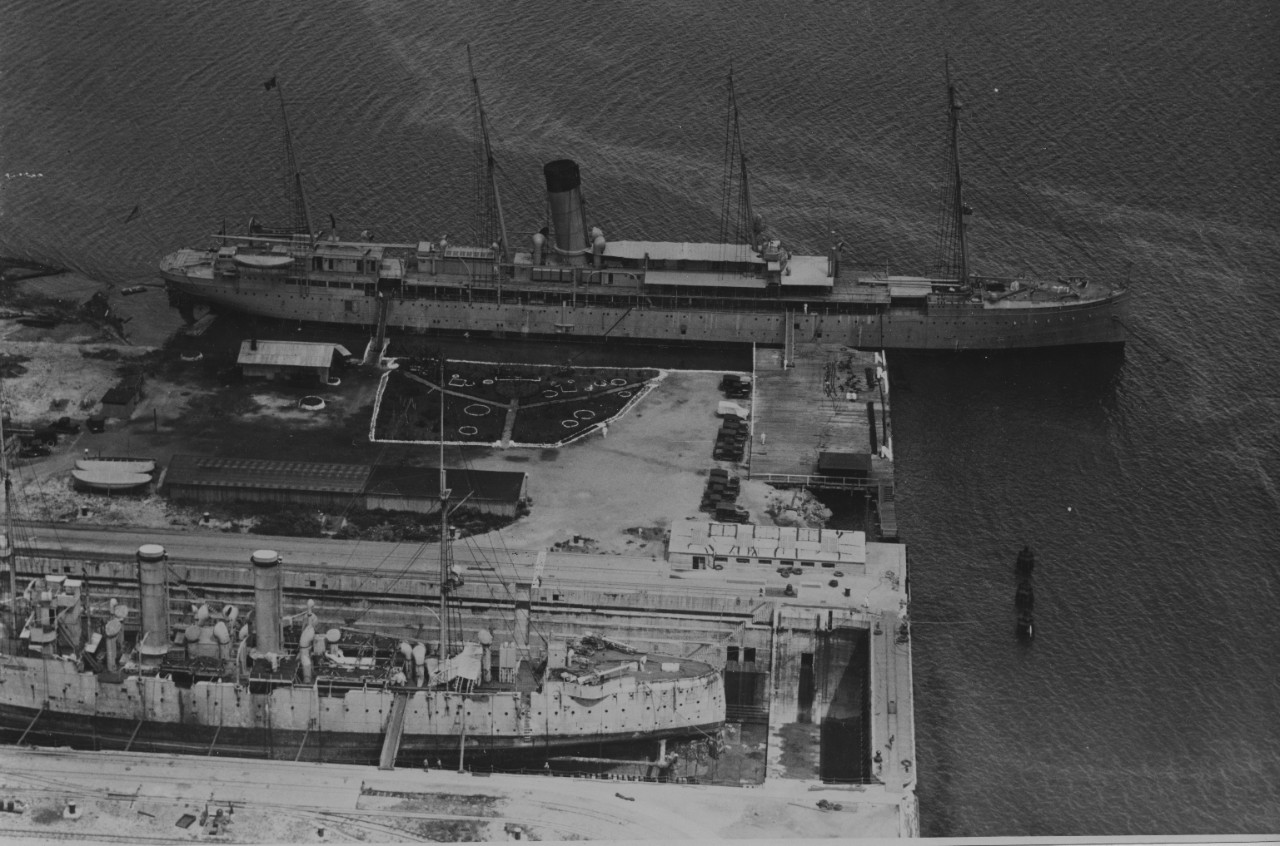
Hancock was towed from Pearl Harbor on 10 July 1925, touching at San Francisco on 24 July, before shifting to the Mare Island Navy Yard, on 25 July. Placed out of commission on 1 September 1925; Hancock was stricken from the Navy list on 10 September, and sold on 21 May 1926.
| Commanding Officers | Dates of Command |
| Lt. Cmdr. Frederick W. Coffin | 20 November 1902 – 9 March 1903 |
| Capt. William H. Emory | 21 September 1903 – 9 November 1906 |
| Lt. Cmdr. George C. Day | 9 November 1906 – 16 March 1907 |
| Capt. William H. Reeder | 16 March 1907 – 1 July 1907 |
| Lt. Ernest L. Bennett | 1 July 1907 – 12 July 1907 |
| Capt. Nathan E. Niles | 12 July 1907 – 1 December 1908 |
| Capt. Samuel W. B. Diehl | 1 December 1908 – 15 June 1909 |
| Lt. Cmdr. Charles A. Brand | 15 June 1909 – 2 September 1909 |
| Lt. Pope Washington | 2 September 1909 – 2 November 1909 |
| Capt. Walter C. Cowles | 2 November 1909 – 27 November 1910 |
| Capt. James T. Smith | 27 November 1910 – 11 July 1911 |
| Lt. Pope Washington | 11 July 1911 – 22 July 1911 |
| Cmdr. John D. McDonald | 22 July 1911 – 27 December 1911 |
| Capt. James P. Parker | 27 December 1911 – 30 March 1912 |
| Lt. Cmdr. Cassius B. Barnes | 30 March 1912 – 3 April 1912 |
| Capt. William R. Rush | 3 April 1912 – 6 August 1913 |
| Cmdr. Arthur L. Willard | 6 August 1913 – 3 June 1915 |
| Cmdr. Ernest L. Bennett | 3 June 1915 – 23 July 1915 |
| Lt. Charles W. Densmore | 23 July 1915 – 3 August 1915 |
| Lt. Horace T. Dyer | 3 August 1915 – 13 November 1915 |
| Lt. (j.g.) Jacob L. Hydrick | 13 November 1915 – 15 March 1916 |
| Cmdr. Edwin T. Pollock | 15 March 1916 – 29 July 1917 |
| Lt. Archibald D. Turnbull | 29 July 1917 – 20 August 1917 |
| Cmdr. William L. Littlefield | 20 August 1917 – 17 August 1918 |
| Cmdr. Wilbert Smith | 17 August 1918 – 28 June 1919 |
| Cmdr. William W. Smyth | 28 June 1919 – 14 October 1919 |
| Lt. Thomas J. Virden, USNRF | 15 March 1920 – 22 March 1920 |
| Capt. John G. Church | 22 March 1920 – 23 June 1921 |
| Cmdr. Charles C. Moses | 23 June 1921 – 7 December 1923 |
| Cmdr. Robert A. Abernathy | 7 December 1923 – 5 May 1925 |
| Lt. Vernon C. Bixby | 5 May 1925 – 10 September 1925 |
Christopher B. Havern Sr.
13 December 2017


